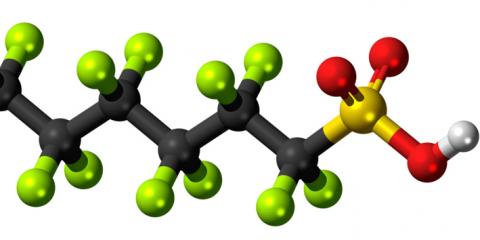Reaction: Research finds PFAS in toilet paper discharged into US wastewater
US scientists have found perfluoroalkylated and polyfluoroalkylated substances (PFASs) in sewage sludge from toilet paper waste. The research, published in the journal Environmental Science & Technology Letters, analysed the presence of these persistent and potentially harmful compounds in toilet paper rolls sold in North, South and Central America, Africa and Western Europe. These substances were compared with those detected in samples of sewage sludge from sewage treatment plants in the United States.

Julián Campo - PFAS rollo EN
Julián Campo
Member of the Food Security and Environment Research Group of the Desertification Research Centre (Valencia)
Perfluoroalkylated and polyfluoroalkylated substances (PFAS) are chemical compounds that, due to their properties - they are non-flammable, thermodynamically stable and highly resistant - are used in a range of industrial and commercial applications such as non-stick cookware, food packaging, insecticides, and waterproof and flame retardant fabrics. According to the most recent research, more than 200 use categories and subcategories have been identified for more than 1,400 PFAS compounds. Due to these same properties, PFASs are considered to be extremely persistent in the environment, highly toxic and with the potential to bioaccumulate and biomagnify up the food chain, and have been detected in wildlife and represent a clear potential hazard to human health. In general, these compounds can act as endocrine disruptors and may have many other toxic effects, such as hepatotoxicity, immunotoxicity, reproductive toxicity and tumourigenic effects, among others.
PFASs can reach the environment, after domestic use, through effluents from Waste Water Treatment Plants (WWTPs) and sludge from these plants. Now, Dr Timothy G. Townsend's research group at the University of Florida has published a paper in the ACS's Environmental Science & Technology Letters warning of an unexpected source of these substances in wastewater systems: toilet paper. The researchers hypothesise that some toilet paper manufacturers may add PFASs during the manufacturing process that converts wood to pulp, adding that recycled toilet paper could be made from fibres derived from PFAS-containing materials.
Townsend and his group analysed samples of toilet paper from North, South and Central America; Africa; and Western Europe for 34 PFASs. They also analysed samples of sewage treatment plant (WWTP) sludge from the USA and detected several of these compounds, including disubstituted polyfluoroalkylphosphates (diPAPs) and, most notably, diPAP 6:2, which was the most abundant in both types of samples, albeit at very low concentrations, in the order of parts per billion. These results are very important as diPAPs can be converted into other more stable PFASs, such as perfluorooctanoic acid (PFOS), whose production was already banned by the EU in 2008, after being considered as a persistent organic pollutant in the Stockholm Convention, as it is potentially carcinogenic.
A study published in 2013 by the research group on Food and Environmental Safety of the University of Valencia (SAMA-UV) highlighted the role of WWTPs as possible sources of PFAS contamination in different basins in Spain (Ebro, Guadalquivir, Júcar and Llobregat). The results of the research by Townsend's group confirm these conclusions and add an important factor to be taken into account, such as toilet paper. The researchers calculated that toilet paper contributed approximately 4 % of the diPAP 6:2 in wastewater in the USA and Canada, 35 % in Sweden and up to 89 % in France. As they conclude in their study, toilet paper can be considered a source of PFAS for wastewater treatment systems, becoming a major source in some places.
Marieta Fernández - PFAS rollo EN
Mariana F. Fernández Cabrera
Professor at the University of Granada and researcher at the Cybernetics Centre for Epidemiology and Public Health (CIBERESP) and the Institute for Biomedical Research of Granada (ibs.GRANADA)
Wastewater analysis can provide information on chemical compounds to which the population has been exposed, and suggest sources of exposure. A paper recently published in the journal Environmental Science & Technology Letters has identified toilet paper as a source of exposure to perfluoroalkylated compounds. PFASs are synthetic compounds consisting of perfluorinated carbon chains, which give them high chemical and thermal stability and resistance to degradation, accumulating over time in the environment and in living organisms. These chemical compounds are highly hazardous to both the environment and humans.
The presence of PFASs in cosmetics, personal care and cleaning products, as well as in textiles and food packaging, was already known - but not in toilet paper, which has turned out to be a form of transport that reaches the environment by ending up in wastewater. The researchers analysed toilet paper from different countries (North, South and Central America, Africa and Western Europe), as well as samples of sewage sludge from sewage treatment plants in the United States. They investigated the presence and concentration of 34 different PFASs, detecting mostly disubstituted polyfluoroalkylphosphates (diPAPs) (diPAP 6:2) at concentrations in the parts per billion range. diPARs can be converted to more stable PFASs - such as perfluorooctanoic acid, which is classified as potentially carcinogenic.
Using this information, together with results from other studies where PFASs had been measured in wastewater, and taking into account per capita toilet paper use, the researchers calculated the percentage contribution of PFASs from toilet paper to wastewater, resulting in 4% in the US and Canada, 35% in Sweden and up to 89% in France, revealing that in some countries it may be a significant source of exposure.
PFASs found in US wastewater may come not only from toilet paper, but also from the use of cosmetics, textiles, food packaging, as suggested by the researchers.
Much more should be done to prevent public exposure to PFASs and to protect both human health and the environment.
Jake T. Thompson et al.
- Peer reviewed
- Letter



